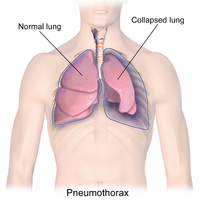
Photo from wikipedia
OBJECTIVE In this study, we evaluated the clinical characteristics and seasonal distribution of patients with primary spontaneous pneumothorax and examined the relationships between meteorological factors and pneumothorax development overall and… Click to show full abstract
OBJECTIVE In this study, we evaluated the clinical characteristics and seasonal distribution of patients with primary spontaneous pneumothorax and examined the relationships between meteorological factors and pneumothorax development overall and in terms of first episode and recurrence. METHODS The hospital records of 168 pneumothorax patients treated in our clinic between January 2016 and December 2020 were reviewed retrospectively. A cluster was defined as two or more patients with pneumothorax presenting within three consecutive days. Meteorological factors were compared between days with and without pneumothorax patients. This comparison was based on meteorological data from the day of symptom onset (D), the day before symptom onset (D1), and the difference between those days (D-D1). Meteorological data from the index day (D) were also compared between patients with first episode and recurrence of pneumothorax. RESULTS The study included 149 (88.7%) men and 19 (11.3%) women. The mean age was 25.02±6.97 (range, 17-35; median, 26) years. Of note, 73 (43.4%) patients underwent surgery. The highest number of patients presented in November (n=19, 11.3%). In terms of season, most presentations occurred in autumn. Humidity was significantly lower on recurrence days compared with first episode (p=0.041). CONCLUSION Our results indicated that meteorological factors (i.e., atmospheric pressure, humidity, wind speed, temperature, and precipitation) were not associated with pneumothorax development. By comparing the patients with first episode and recurrence, the humidity was significantly lower in the recurrence group.
Journal Title: Revista da Associacao Medica Brasileira
Year Published: 2022
Link to full text (if available)
Share on Social Media: Sign Up to like & get
recommendations!